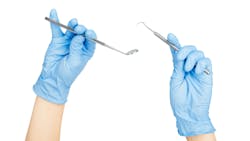Handle with care: Intentional wellness for hygienists’ hands
I've never met a one-handed practicing hygienist. That's because our hands are our livelihood. We use them to make precise, repetitive motions throughout our entire day, for every surface of every tooth that we scale, polish, floss, and provide care to. The kinesthetic feedback we receive through our fingers while holding an instrument in a firm grasp while performing smooth, steady strokes is more complex than we give our hands credit for. It's quite miraculous. But over time, this repetitive practice can take a serious toll on our bodies.
MSDs and hand movement
Musculoskeletal disorders (MSDs) are rampant among dental professionals-and hygienists are particularly vulnerable due to the repetitive nature of our work. Combine that with prolonged static posture, forceful gripping of instruments, poor ergonomics, and a lack of hand health preventive measures, and it's no surprise that up to 70% of dental hygienists report hand or wrist pain at some point in their careers.1 Hygienists are less likely to return to work after hand and wrist injuries than any other common work-related injury.2
The worst part is that many of us overlook proactive care until discomfort escalates into pain or dysfunction. Prioritizing hand health is not just about career longevity-it's also about comfort and quality of life.3 The foundation of hand health starts with ergonomics; we need to be mindful and consistent when we practice. Maintaining a neutral wrist position, ensuring proper finger posture, and applying appropriate pressure with an adequately sharp instrument that is ergonomically designed can significantly reduce strain and injury.
The most common hand/wrist conditions for hygienists include:
-
Carpal tunnel syndrome (CTS): Caused by compression of the median nerve in the wrist, leading to numbness, tingling, and weakness in the hand
-
De Quervain's tenosynovitis: Inflammation of the tendons on the thumb side of the wrist, causing pain and difficulty with grip
-
Trigger finger: A condition where fingers lock or catch when bent due to tendon inflammation
-
Wrist tendinitis: Inflammation of tendons in the wrist from repetitive strain.
The handling of instruments
-
Instrument selection: Lightweight, larger-diameter instruments with textured grips reduce the pinch force required to hold them securely during scaling and assessing (yes, this also includes diagnostic instruments like mirrors, explorers, and probes).4,5 Since we have different hands, instruments are going to feel and work differently for each person, so try a variety of shapes and materials.
-
Use sharp instruments: Dull instruments require an increase in the force you need to exert to remove calculus, stressing the hand muscles. Keep those instruments sharp! Most don't enjoy sharpening and studies show that we aren't as accurate as we think we are, so utilizing sharpen-free instruments or sharpening services is an option.6
-
Use the right tool for the job: Supra means supra and universal is rarely completely universal. Don't let the pressure of time stop you from grabbing a different instrument to more effectively get to one of those hard-to-reach places. I'm looking at you, number 15 distal!
-
Optimize patient positioning: Position your patients and yourself to minimize awkward wrist angles. Tilt the headrest back and make sure that the oral cavity is at elbow height with the forearm parallel to the floor to achieve neutral positioning.
Getting a handle on grip strength
Grip strength is a surprisingly powerful predictor of overall hand health and life span. It supports endurance for longer procedures, career longevity, and reduces fatigue when using hand instruments. It also helps us securely hold onto that cup of coffee when we reach our golden years! Studies have shown that professionals with better grip strength report fewer instances of hand pain and functional limitations.7
Unfortunately, repetitive dental work can lead to grip fatigue and weakness if grip strength not actively maintained. Incorporating grip-strengthening exercises into your routine can help counteract this. Dr. Peter Attia recommends carrying 75% of our body weight for one minute in females and 100% of our body weight in males.8
Simple grip strength exercises:
-
Stress/putty ball squeezes: Hold a stress ball or therapy putty, squeezing for three to five seconds and releasing. Aim for two to three sets of 10-15 repetitions daily.
-
Hand grippers: Use hand grip trainers for controlled strengthening. Squeeze, hold, release. 10-15 repetitions twice daily.
-
Towel wringing: Twist a wet towel tightly in both directions to engage hand and wrist muscles. See how much water will come out of the towel. Aim for two minutes.
-
Carry/weight training: Carrying heavy things (a dumbbell, barbell, kettlebell, etc.) strengthens the gripping muscles of the hands. Lifting weights for other exercises inadvertently leads to grip strength without dedicating time solely to grip strength exercises. Bonus!
-
Hanging: Hang from a bar. Be it at a playground or a pullup bar over a doorway in your house, hanging directly strengthens grip strength.
Stretches and exercises for hand health
Stretching and strengthening exercises help combat stiffness, improve flexibility, and prevent injuries. It is imperative that we make time to stretch our overworked hands and lubricate our joints. Studies show that stretching also helps us become more aware of our ergonomic practices!9 Here are examples of stretches that can be done in less than a minute:
-
Wrist flexor stretch: Extend one arm in front, palm up. Use the other hand to gently pull the fingers back toward the body until a stretch is felt. Hold for 15-30 seconds, then put the palm facing down and gently pull the fingers back for 15-30 seconds and switch sides.
-
Finger stretches: Spread the fingers wide apart and hold for five seconds. Then make a fist and squeeze lightly. Repeat 10 times.
-
Thumb stretch: Gently pull the thumb back with the other hand to stretch the muscles at the base of the thumb. Hold for 15-30 seconds.
-
Tendon glides: Fold the fingers down flat onto the palm, then slide them up the palms go into full extension of the fingers. Do the same with the thumb.
-
Median nerve glides: Extend an arm to the side, fingers extended out. Move the palm up to face out, while tilting the head away and return. Repeat 10-15 times.
Listen to your body
Perhaps the most critical component of hand health is early awareness. Pay attention to the early warning signs of overuse like tingling, numbness, and aching. Seek professional evaluation if symptoms persist and evaluate your workload. Consistency in prevention is key.
Integrating stretching and strengthening exercises before or after work, or even during short breaks, can have profound cumulative benefits. Additionally, tasks like room turnover or oral hygiene instruction, and self-care practices like warm soaks, paraffin wax treatments, and even massage therapy can provide relief and slow the injury process down. Ultimately, as prevention specialists, we know more than most that an ounce of prevention is worth a pound of cure! We just need to be mindful about practicing prevention for our own benefit!
Editor's note: This article appeared in the July 2025 print edition of RDH magazine. Dental hygienists in North America are eligible for a complimentary print subscription. Sign up here.
References
-
Hayes M, Cockrell D, Smith DR. A systematic review of musculoskeletal disorders among dental professionals. Int J Dent Hyg. 2009;7(3):159- 165. doi:10.1111/j.1601-5037.2009.00395.x
-
Akesson I, Johnsson B, Rylander L, et al. Musculoskeletal disorders among female dental personnel--clinical examination and a 5-year follow-up study of symptoms. Int Arch Occup Environ Health. 1999 Sep;72(6):395-403. doi: 10.1007/s004200050391
-
Vaishya R, Misra A, Vaish A, et al. Hand grip strength as a proposed new vital sign of health: a narrative review of evidences. J Health Popul Nutr. 2024 Jan 9;43(1):7. doi:10.1186/s41043-024-00500-y
-
Suedbeck JR, Tolle SL, McCombs G, et al. Effects of instrument handle design on dental hygienists' forearm muscle activity during scaling. J Dent Hyg. 2017;91(3):47-54.
-
Sanders MJ, Turcotte, C, Fraser T. Ergonomic considerations for dental hygienists. Work. 2020.
-
Laughter L. Your best efforts! Author's informal survey indicates that dental hygienists do not retain sharpening skills. RDH. April 14, 2015. https://www.rdhmag.com/patient-care/article/16405319/your-best-efforts-authors-informal-survey-indicates-that-dental-hygienists-do-not-retain-sharpening-skills
-
Jepsen JR, Laursen LH. Grip strength in ergonomic studies: A systematic review. Journal of Hand Therapy. 2009.
-
The Tim Ferriss Show podcast. #661. Dr. Peter Attia. The science and art of longevity. March 14, 2023. Accessed April 24, 2025. https://podclips.com/c/o6w7uS?ss=r&ss2=peterattia&d=2023-06-26&m=true
-
Nye WH, Partido BB, DeWitt J, et al. Prevention and reduction of musculoskeletal pain through chair-side stretching among dental hygiene students. J Dent Hyg. 2021;95(1):84-91. PMID: 33627457
About the Author

Katrina Klein, RDH, CEAS, CPT
Katrina is an 18-year registered dental hygienist, national speaker, author, competitive bodybuilder, certified personal trainer, certified ergonomic assessment specialist, and biomechanics nerd. She’s the founder of ErgoFitLife, where she teaches that ergonomics and fitness are a lifestyle to prevent, reduce, and even eliminate workplace pain. You can reach Katrina at [email protected].
